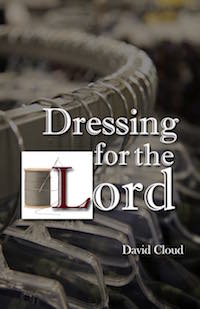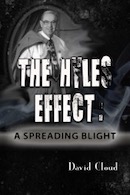866-295-4143, fbns@wayoflife.org

Wikipedia defines fashion as “a prevailing mode of expression.” It acknowledges that “every article of clothing carries a cultural and social meaning” and observes that “humans must know the code in order to recognize the message transmitted.”
The knowledge of this is the engine that drives the fashion industry, and the child of God needs to understand it, as well.
I need to ask myself what message is my clothing broadcasting?
American fashion designer Rachel Zoe said, “Style is a way to say who you are without having to speak” (goodreads.com).
“Clothes change our view of the world, and the world’s view of us” (Feminist writer Virginia Woolf, Orlando, chapter 4).
“Choose your clothes for your way of life” (American actress Joan Crawford, azquotes.com).
“Style is a simple way of saying complicated things” (Jean Cocteau, French designer, playwright, filmmaker, goodreads.com).
“Every day I’m thinking about change” (Miuccia Prada, Italian fashion designer, brainyquote.com)
“Basically I’m trying to make men more sensitive and women stronger” (Miuccia Prada, Italian fashion designer, brainyquote.com).
“What you wear is how you present yourself to the world, especially today, when human contacts are so quick. Fashion is instant language” (Miuccia Prada, Italian fashion designer, “Interview: ‘Fashion Is How You Present Yourself,’” Wall Street Journal, Jan. 18, 2007).
“I’ve realized that fashion is a very powerful instrument that ... allows you to transmit ideas and shape opinion” (Miuccia Prada, Italian fashion designer, “Interview: ‘Fashion Is How You Present Yourself,’” Wall Street Journal, Jan. 18, 2007).
“... there are sociological interests that matter to me, things that are theoretical, political, intellectual and also concerned with vanity and beauty that we all think about but that I try to mix up and translate into fashion” (Miuccia Prada, Italian fashion designer, brainyquote.com).
George Harrison of the Beatles, who rebelled against the way his father wanted him to act and dress, testified: “Going in for flash clothes, or at least trying to be a bit different … was part of the rebelling. I never cared for authority” (Hunter Davies, The Beatles, p. 39).
Mary Quant was the revolutionary British fashion designer of the Beatles era, and her clothing was definitely a language. In 2019, the Victoria & Albert Museum in London had a major exhibit on Quant, inventor of the mini-skirt and hot pants. The focus of the exhibit is revolution, liberation from biblical sexual mores, and breaking down the barriers between the sexes (unisex, androgyny). There was no attempt to hide this. Quant put women in men’s attire: pants, ties, suit jackets, and short hair. One display, entitled “Boys Will Be Girls,” says that Quant “subverted menswear.” “Trousers are considered inappropriate for women [but] Quant wears them anywhere she wants.” Mary Quant knew that trousers on women is not an issue merely of comfort and freedom of movement. Following are some other quotes from the exhibition signage: “using fashion to question hierarchies and gender rules,” “a rebellious approach to established gender norms,” “mocking religion,” “an independent style,” “self-expression,” “freedom.” “The miniskirt became an international symbol of women’s liberation.” “[Quant’s] provocative styles reflected increasingly relaxed attitudes in society towards sexuality in all its forms, reinforced legally by the decriminalisation of homosexuality in 1967.” Quant also broke down the barriers between ages, dressing women in girl’s fashions. She said, “I didn’t want to grow up.” The 1960s was a major changing of the times. It was the dawn of the era of color television, color printing, international mass marketing, global merchandising empires. Why were Quant’s fashions so popular? Why does a Quant exhibit at a major art museum draw thousands of eager visitors? She helped create the modern ME culture, the “lovers of their own selves” generation prophesied in 2 Timothy 3:2. The music, the fashion, the entertainment, the commerce, it all broadcasts the lie, “It’s your life; live as you please!”
Vivienne Westwood, who helped create the rock punk look, said, “I think fashion is the strongest form of communication there is. … It’s only interesting to me if it’s subversive: that’s the only reason I’m in fashion, to destroy the word ‘conformity’” (Jon Savage, Time Travel: Pop, Media and Sexuality 1976-96, p. 119).
David Kidd once posed the following question to a young college girl who was inquiring about his family’s conservative dress: “If you are shopping and see a girl in a long, loose fitting dress, what is your first impression of her?” Without any hesitation, she answered “that she is probably religious.” He concluded, “It behooves us to recognize that our manner of dress is a statement that either reflects or contradicts our Christian purpose” (The Fall and Rise of Christian Standards, p. 154).
Hair styles are also statements. Long hair on men and short hair on women are not merely harmless fashions, a mere sign of the times, but are statements of rebellion against God’s created order (1 Corinthians 11:14-15).
The androgynous unisex image is not innocent. It was created by people who intended to overthrow tradition. One of the rock songs of the 1960s called upon young men to grow their hair long and “let your freak flag show.” David Lee Roth of Van Halen testified: “[My long hair] is a flag. It’s Tarzan. I’ll always be anti-establishment” (cited by John Makujina, Measuring the Music, p. 73).
Mary Quant not only dressed in pants, she wore her hair very short as a unisex statement.
Dennis Wilson of the Beach Boys sported long hair and popularized the “surfer cut” in the early 1960s. Commenting on the significance of this hair length, Wilson’s biographer observes: “The ‘surfer cut,’ as it came to be known, was a radical thing to behold in 1962. Few parents would permit their sons to sport the look” (Jon Stebbins, Dennis Wilson: The Real Beach Boy, p. 24). Dennis Wilson was a rebel and his appearance was merely a reflection of this. Observe, too, that the “surfer cut” was not that long compared to the long hair that came afterwards, but it was just long enough to be a bold statement of non-conformity. Small fashion changes can have large consequences.
Paul McCartney of the Beatles flippantly acknowledged their role in overthrowing sexual distinctions: “There they were in America, all getting house-trained for adulthood with their indisputable principle of life: short hair equals men; long hair equals women. Well, we got rid of that small convention for them. And a few others, too” (Barbara Ehrenreich, “Beatlemania: Girls Just Wanted to Have Fun,” cited by Lisa Lewis, The Adoring Audience: Fan Culture and Popular Media, p. 102).
Where did the “small convention” of “short hair equals men; long hair equals women” come from? Why was this an “indisputable principle of life” in America prior to the onslaught of Beatles’ style rock & roll in the 1960s? The answer is that America, because of its vast number of churches, had been influenced by the Bible in these things. It was Bible principles that the Beatles ridiculed and sought to overthrow.
Abercrombie & Fitch, the clothing company that markets “edgy” clothing featuring loose sexuality, is “best known for its REBELLIOUS ATTITUDE” (“Flip-Flops, Torn Jeans, and Control,” Business Week, May 30, 2005). Thus even the world recognizes the message of Abercrombie & Fitch clothing. They don’t merely sell clothing; they sell an attitude via a certain style of clothing.
In “The World according to Abercrombie and Fitch,” David Seel observed: “SUCCESSFUL BRANDS IN AMERICA DON’T SELL PRODUCTS. THEY SELL LIFESTYLES” (Critique, 2000).
The upscale unisex Pusch brand was developed by two brothers who realized as teenagers that “music had its own subculture, complete with a lifestyle and a style of dress” (“Groovin’ to the Right Tune: A Lifestyle Brand of Clothes Inspired by Calgary’s Music Scene Rocks the Competition,” Alberta Venture, October 2007, p. 12). The Pusch brand is a reflection of the rock & roll dance scene.
Of the “Distressed Look” (faded, tattered, patched, holey clothing), Charlene Lau, a fashion historian who has taught at Parsons School of Design, says it “tends to work against middle-class norms of cleanliness and propriety ... they are symbolic of rebellion--whether real, contrived, or imagined.” And Nancy B. Diehl, director of New York University’s Costume Studies program, says, “It’s a protest against propriety.” One distressed-wearing female said of trash clothes, “They lend an air of super casualness to your personality and make you just a bit more careless and carefree” (Don Boys, “The War on Modesty Decorum, and Appropriateness!” cstnews.com, Jan. 30, 2019).
Even the small details of clothing are significant as a language. Referring to the denim jean market in the 21st century, the web site fashionera.com observes that this market “is status ridden and has CODED TRIBAL SIGNS AND SIGNALS with it’s not so subtle stitching, logos, tabs, decorative pockets, shading and distressing.”
Therefore, clothing styles are not innocent. Each style preaches a message. Fashion designers are change agents.
Pantsuits preach the feminist’s message of equality of the sexes.
Tight fitting, low cut, short and skimpy styles preach the world’s message of loose sexuality.
Ripped jeans preach the message of a cheap affectation of poverty, of “I don’t care” and thus slovenliness, and of moral casualness.
Slit skirts preach the message of sexual flirtation.
God’s people must beware of sending the wrong message with their clothing. We must understand that the clothing industry is not in submission to God and cares nothing about submitting to His Word.
It doesn’t do to say, “Well, my tight, ripped jeans don’t preach that message TO ME.” The important point is not what message the clothing preaches to any particular individual who wears it, but what message it preaches in the context of its history and in the context of society at large and to those who are forced to look at it.
The child of God should ask, “Who invented this type of dress, this particular fashion, and what was his or her objective, and what message does this fashion have in culture today?”
“Wherefore be ye not unwise, but understanding what the will of the Lord is” (Eph. 5:17).
“Whether therefore ye eat, or drink, or whatsoever ye do, do all to the glory of God. Give none offence, neither to the Jews, nor to the Gentiles, nor to the church of God: Even as I please all men in all things, not seeking mine own profit, but the profit of many, that they may be saved” (1 Cor. 10:31-33).
- Receive these reports by email
- www.wayoflife.org
______________________
Sharing Policy: Much of our material is available for free, such as the hundreds of articles at the Way of Life web site. Other items we sell to help fund our expensive literature and foreign church planting ministries. Way of Life's content falls into two categories: sharable and non-sharable. Things that we encourage you to share include the audio sermons, O Timothy magazine, FBIS articles, and the free eVideos and free eBooks. You are welcome to make copies of these at your own expense and share them with friends and family. You may also post parts of reports and/or entire reports to websites, blogs, etc as long as you give proper credit (citation). A link to the original report is very much appreciated as the reports are frequently updated and/or expanded. Things we do not want copied and distributed are "Store" items like the Fundamental Baptist Digital Library, print editions of our books, electronic editions of the books that we sell, the videos that we sell, etc. The items have taken years to produce at enormous expense in time and money, and we use the income from sales to help fund the ministry. We trust that your Christian honesty will preserve the integrity of this policy. "For the scripture saith, Thou shalt not muzzle the ox that treadeth out the corn. And, The labourer is worthy of his reward" (1 Timothy 5:18). Questions? support@wayoflife.org
Goal:Distributed by Way of Life Literature Inc., the Fundamental Baptist Information Service is an e-mail posting for Bible-believing Christians. Established in 1974, Way of Life Literature is a fundamental Baptist preaching and publishing ministry based in Bethel Baptist Church, London, Ontario, of which Wilbert Unger is the founding Pastor. Brother Cloud lives in South Asia where he has been a church planting missionary since 1979. Our primary goal with the FBIS is to provide material to assist preachers in the edification and protection of the churches.
Offering: Offerings are welcome if you care to make one. If you have been helped and/or blessed by our material offerings can be mailed or made online with with Visa, Mastercard, Discover, or Paypal. For information see: www.wayoflife.org/about/makeanoffering.html.





